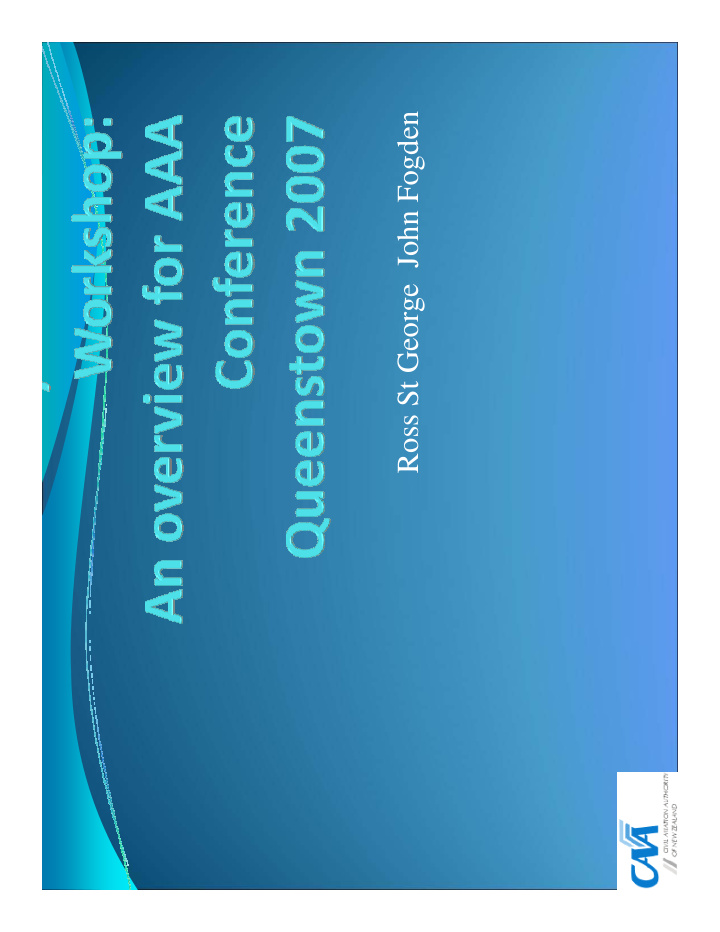



Ross St George John Fogden
� Two Day Workshop � Responsibilities of the Senior Person/Chief Pilot in a certificated organisation � Civil Aviation Act 1990 and Rules. � The role of the Exposition � Say what you do. Do what you say
CAA1 CAA2 CAA3 • Two courses have been run. Two in planning. • Over 50 participants for 135, 137 and flight training organisations. • All have ‘Senior Persons, Chief Pilots or Chief Flying Instructors’. Themes : - � Knowing the game. � Keeping up with play. � Getting ahead of the game.
Slide 3 CAA1 Civil Aviation Authoritty, 14/09/2007 Civil Aviation Authoritty, 14/09/2007 CAA2 CAA3 Civil Aviation Authoritty, 14/09/2007
• 137 Chief Pilot. Cannot exercise a 137 without one. • Chief Pilot is approved by the Director of CAA. • CAA Act Sections 10 –Fit and Proper Person, and 12 – Requirements for participants in the civil aviation system. • 137 Chief Pilot is in a position of responsibility and is the senior person with oversight for the operations. In other words-supervision.
� These responsibilities can be summarised as:- � Setting professional standards and regulatory adherence by pilots and staff. � Flying discipline � Work place safety (strip/pad conditions, aircraft,loading equipment, refuelling etc) � Quality of workmanship ( client relationships, other agency requirements)
• Maintenance of records related to equipment. • Maintenance of records relating to staff. Currency and training. • Reporting of accidents, incidents and occurrences under CAR 12. • Staff development and training: company practices, relevant aviation safety updates, product information, OSH material, CAA regulatory information.
� Other duties assigned and agreed to within the company. � Setting the company culture. � AND...the really big one:- proper supervision of Grade ll pilots and a watchful/helpful eye on Grade l pilots in your employ.
� The Senior Person/ Chief Pilot workshop covers:- � The CAA Act The Rules The Advisory Circulars The Exposition/ Company Manual � Communication in a company. Sharing information. � Standard Operating Procedures. Formalised or informal.
� Rostering, work management (a tricky one in the 137 world), fatigue management, HSE and QA issues ( doing a good job –to attract the business next year). � Those records that must or should be kept and preparation for audits (CAA or otherwise). � Training in the organisation ( no one knows it all)
� Checking and training management. � Hiring and firing issues. � Due process . � Safety reporting/in-house emergency actions and media matters. � Leadership and the company culture developed by the Chief Pilot.
Comments from the CP Workshops � The Chief Pilot Position: “ Managerial competencies – the role goes well beyond just flying”. � SOPs: “can be supplemented reflecting experience and re- visited for specific or new operations” � Training:“Handling in flight distractions (cell phones, GPS), emergencies , low level hazards.”.
• Training: “In ag ops –supervision and development needs to be well beyond Rule minimum hours”. • Competency checking. “Handling a check failure – training input, preparedness?” • Hiring: “Hire in haste: repent at leisure”. • CP Communications: “Well organised and topic focused safety and operational meetings”
� CP Position Challenges: “Keeping his finger on the pulse” � CP Position Challenges: “ If all responsibilities rest with one person there really is no internal checking ”. (The one-man band). � CP Position Challenges: “ Managing the feast or famine with work demands...and having a life”.
Can any of this help with John Fogden’s 137 Senior Person Questionnaire? • Maybe. John has 37 questions ( and growing?) Q4. What do you consider to be a reportable incident? ( Knowing to refer to Part 12 – and the precautionary principle should help). Q14. What records must a CAR 137 Operator maintain? ( You’ll find that out – if you were uncertain), Q17. Is it legal to do a spray turn over the neighbour’s boundary? ( Better be certain all your pilots know).
Recommend
More recommend